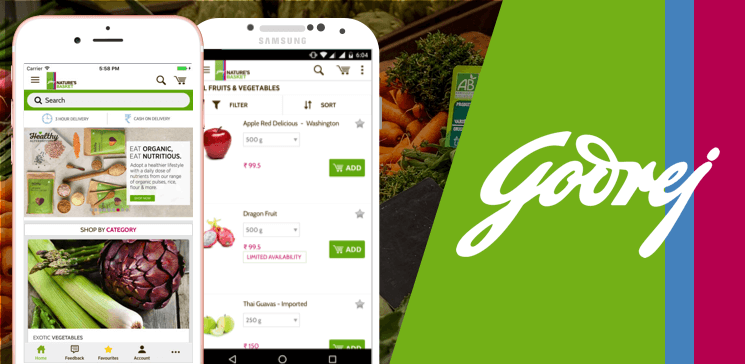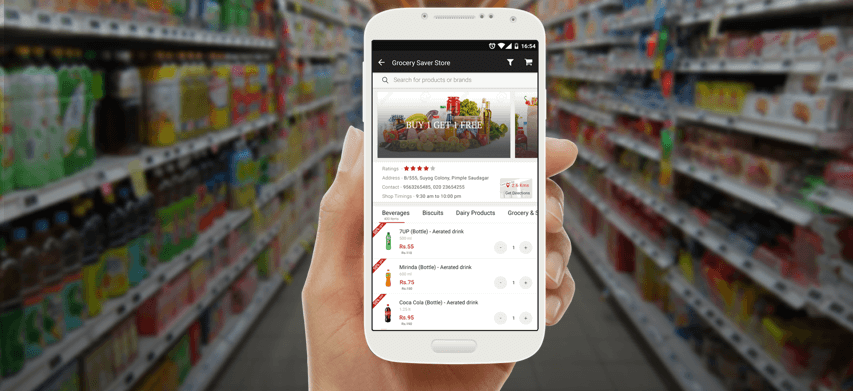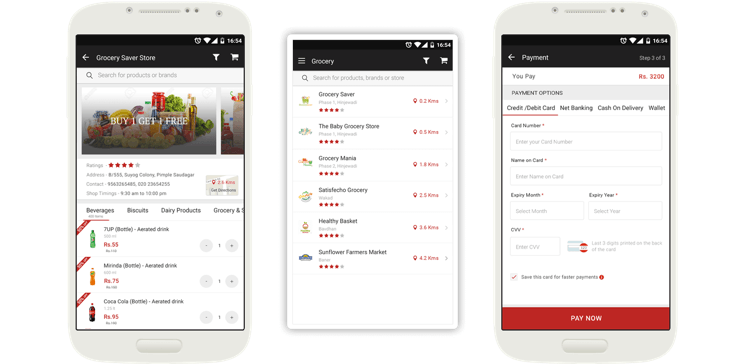Tech innovations in mobility have revolutionized processes across sectors. When it comes to assessing its impact on retail, you just can’t deny how technology has streamlined processes in this channel. Consumers wish to gain uninhibited access to a wide assortment of products, which also includes groceries and daily essentials. At least, that’s what the current trends say! Quite naturally, they are looking for unique shopping experiences which are constantly pushing them towards online supermarkets, grocery delivery services, and grocery shopping apps.
If the latest market stats are anything to go by, supermarkets are planning to make it big in the retail space by the end of 2025.
The Challenges
That brings us to the pivotal part of this discussion. Grocery shopping will always be an integral part of a consumer’s daily shopping experience. However, market trends will change and evolve with time. Traditional supermarkets need to keep up with these changes thus ensuring unmatched buying experiences for consumers. Even traditional grocers will have to grow, evolve, and embrace technological changes as that will be the key to higher ROIs and profits. Or else, they might lose the game to online grocery shopping apps and sellers like Amazon, Bigbasket, and others.
- Lack of varied stocks
A local store will be good at keeping local brands and distributing it to customers in the locality. However, when it comes to branded products, it becomes difficult for local stores to stock these. Even today, skimmed milk for the fitness aficionados is considered upmarket and is not available at many grocery stores. Similar is the case with packaged foods. This lack of variety has customers looking for more options. - Geographical limitation
A local grocery business depends on customers coming from local proximity. Offline brick and mortar stores are severely restricted by the reach and coverage, unlike an omnichannel grocery shopping business. - Limitations of scale
Because of limited reach, offline grocers are not able to scale up operations the way online grocery businesses can. Amazon’s recent purchase of Whole Foods denotes the huge potential of the online grocery business. Such economies and advantages of scale will not be available to an offline grocery business. - Innovation challenge
New age online retailers and supermarket apps are totally redefining the way grocery business is envisaged. This has not only eroded the market share of offline grocery shops but has led to better customer sentiments for the hyperlocal grocery delivery model. - The cost of real estate
With rising cost of maintaining a physical store, grocery shopping is fast turning out to be a massive concern for shop owners. Not only are they faced with increasing rents, but the stiff competition from successful online grocery businesses is proving to be a detriment to sustainable operations. - Changing customer preferences
Online grocery as an idea has been in existence for quite a while now. However, the idea has really taken off only in the last couple of years. The reason behind this is that customers are now more open to purchasing their daily needs items online. The ease of getting one’s daily household needs delivered at the push of a button is too convenient to ignore.
Mobile Apps In Grocery Retail
There’s no denying how smartphones and apps have become a transformative force for every industry including retail. Let us have a look at the various types of grocery apps available in the market. With distinctive features, each of these apps has something special to offer:
- In-store grocery shopping apps
Every consumer wants to have personalized experiences when they go for grocery shopping. If you wish to ensure that, creating personalized physical store experience will be the right thing to do. In-store grocery apps offer personalized services where shoppers can get an idea of the products, their availability, and location. - E-commerce apps
Brick-and-mortar grocery businesses and online retailers launch these apps to offer grocery delivery services through online channels. - Personalized grocery apps
These apps serve shoppers to better plan their grocery purchases, set reminders, create lists, share with contacts and more.
Grocery App Adoption By Retailers & Grocers

Supermarkets and leading grocery businesses are putting their best foot forward to offer exceptional solutions to their customers. With a large number of renowned brands taking the lead in this context, it is high time for every grocery business to adopt powerful and integrated grocery app strategies. Here’s a list of some of the popular grocery apps:
- Walmart:
As an innovative online and in-store app, Walmart helps customers locate an item, create personalized wish lists, and scan the QR codes on products. Consumers get a much smoother and hassle-free experience while using it. - Spencers –
This brand operates 125 stores with 38 large format stores in almost as many cities across India. It is also planning a foray into online retail in more cities and thus strengthens its omnichannel delivery model for daily grocery needs. - Reliance Retail –
Reliance operates more than 500 Reliance Fresh stores in 80 cities. With an aim to be India’s top online grocery retailer by 2020, Reliance Retail has big plans for this sector. - Godrej Nature’s Basket -
The one of its kind gourmet Indian food retail chain plans to focus on online sales to drive revenue through their branded app and website. - Trader Joe’s:
Check out this in-store grocery shopping app which helps you create customized shopping lists, add favorite items to that list, and also comes with a unique store locator.
These smart grocery shopping apps speak a lot about the current market trends in grocery retail. Integrated shopping processes and unmatched convenience is all that shoppers need. Quite naturally, businesses want to ensure that thus staying ahead of the growth curve.
Grocery App Benefits For Customers
Adding a grocery app to your sales strategy will bring several benefits for your customers and significantly boost customer satisfaction and revenues.
- Convenience
Working professionals find it difficult to make time for grocery shopping. Either they have to spend an evening at the local supermarket stocking up on the available items, or simply have to make do without items of daily needs. With a grocery app, customers can order items with just a few taps on their mobile phones. No need to commute to the supermarket, wait in checkout lines and spend time filling up your cart. Your online cart will be delivered to your doorstep. - Rich browsing & choices
Try checking for goat cheese or fresh jalapenos from your local Kirana store. It is likely that they haven’t even heard of these terms. Now try logging on to a site like Godrej Nature’s Basket. What you get is a delectable assortment of delicatessen, fruits, vegetables, international cuisine, meats, and beverages. This wide variety is what sets apart online grocery business from its offline counterparts. - Ease of checkout
Say goodbye to carrying your purse and keeping change when checking out of the offline retail store. Simply put your feet up, open the app, order your favorite food and beverage, and check out with just a few taps on your mobile. The payment integration provides total security and complete ease of grocery shopping.
Adding The Features: The Keys To A Successful Grocery Shopping App

An innovative, ingenious, and smart mobile app strategy has become essential for a robust grocery business. If you wish to venture into online grocery shopping, make sure you have a robust, scalable, and dynamic app with the following features:
- Simple onboarding process
Let your buyers have a seamless experience while using your grocery app. First impressions are indeed the last impressions and a simple onboarding process will help you achieve that. - Appealing app design
The entire flow of the purchase process has to be smooth, continuous, and non-jarring. - Discounts and Offers
Research has shown that around 1/3rd of the shoppers prefer receiving information about discounts on their mobiles. Also, 2/3rd of the shoppers prefer receiving information in near real-time while they are present at the store. This makes deals and offers a must have feature. - Similar products listing
If a shopper selects a particular type of rice, it will be good to show him/her other types of rice available in the store in that view itself. The presence of options not only helps the shopper to make an informed decision but also enables satisfaction. - Uncluttered and hassle-free navigation
Simple navigation leads to a hassle-free shopping experience. Make sure your customers gain access to their desired items easily. - App Analytics
Leverage app analytics to get a data-driven understanding of how your customers are using the app. Optimize the app based on these insights and feedback to further improve the mobile grocery shopping experience. - Push notifications & alerts
Keep your consumers informed about their order status, latest offers, deals, discounts and more. Drive engagement and app re-use with smart and timely alerts. - Physical store integration
Your target customers can now get their orders at an increased pace. Reduce wait times and offer instant solutions to customers with smart in-store pickup strategies.
How Much Does It Cost To Build A Grocery Shopping App?
The cost of grocery app development will depend on the features and functionality you will be adding to the mobile app. If you are planning to customize it by integrating niche or one-of-its-kind features, then the development cost will increase accordingly.
The developer needs to add features like the ones mentioned below and integrate with existing e-commerce infrastructure like a website if required.
- Customized themes
- Wishlist
- Multiple payment options
- Bar code scanning
- Order tracking
- Coupons, deals, and redemption
- Delivery time slots
- Product search and help section
- Signup page
- Trending products
It’s Time For Grocery Businesses To Embrace Mobile
Grocery shopping apps have the potential to transform shopping experiences from boring to brilliant. Traditional supermarkets will need to embrace them, leverage them, and apply a smart mobile app strategy in the right places. That will take them ahead of the competitors and stay competitive with an omnichannel grocery retail plan built for a mobile first customer base.
If you are looking for a grocery app development partner for your app project, feel free to check out Mobisoft’s grocery app development solution. We offer a fully branded grocery shopping app development solution for supermarkets, grocery chains, aggregators and startups to build and grow their grocery business.





 August 30, 2017
August 30, 2017


